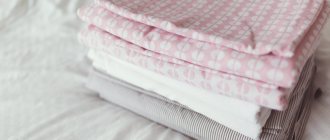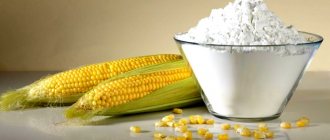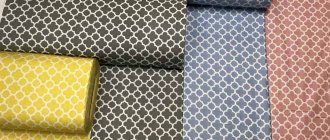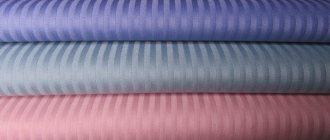Share on social media networks:
Probably, each of us has encountered the problem that clothes don’t look very neat after washing. Even the latest model of washing machine is not always capable of producing high-quality washing, thanks to which things would have a pleasant, rather than faded and washed out appearance. It’s already unpleasant to use them, and not everyone has enough money for new ones. That's why we're going to tell you a few secrets on how to wash washed bedding, such as greasy sheets or yellowed pillowcases, so that it ends up looking like new.
Proper washing technology is the key to success
Do I need to soak laundry before washing it in the washing machine? The first thing you should pay attention to is the correctness of the process of washing bed linen. Of course, an automatic machine greatly simplifies the life of every housewife, because you just need to load things into it and turn on the desired cycle. However, the results of such washing are not always satisfactory. Therefore, to prevent collapses in the future, it is very important to wash dirty bed linen correctly.
This process consists of the following stages:
- Pre-soak using bleaches (for whites) or stain removers (for coloreds).
- Boiling using modern household chemicals.
But if, nevertheless, something went wrong and your bed linen has lost its color and turned yellow-gray, we offer you a number of effective methods that will help solve the problem.
Simple chemistry in everyday life
If the environmental friendliness of the product is not in the first place for the housewife, then you can successfully use household chemicals to add whiteness and remove grayness from clothes. After all, these are the tools that perfectly cope with the task :
- White. Every housewife has it in her kitchen, but frequent use of the product leads to rapid wear and tear of things. But occasionally you can pour a small portion of the product directly into the drum, especially if the stains are not old.
- Domestos. Most often, this product is used for cleaning rooms, toilets and bathtubs. But the label says that you can soak your laundry in it to give it its original color. It is allowed to pour the product directly into the drum of the machine in the amount of one measuring cap, which will help give things a snow-white appearance and remove yellowness.
- Dishwashing liquid. In most cases, things acquire a yellowish tint due to contact with the skin and its secretions. Therefore, to remove stains and yellowing, it is worth adding a little dishwashing detergent directly to the powder compartment. After washing like this, things will look like new.
Experts advise that to prevent laundry from turning gray after washing, you should remove dust from the pockets of items and clean the elastic in the drum more often. Then washing will only be a joy.
Modern means
Today, household chemical stores sell a lot of products that will help you wash washed bedding and restore its attractive appearance and softness.
Laundry soap
Thanks to this product, you can not only remove various stains, but also wash old things. You can simply rub them with laundry soap and leave them in this state for a couple of days, or pre-soak them for several hours in a soap solution and then boil them.
Important! Laundry soap is, in principle, considered a universal remedy for any kind of pollution. Find out why in our article “What is laundry soap made from?”
White
When bleaching white bed linen, unfortunately, you cannot do without this product, as it helps to cope with yellowness and gray washed-out tints. “Whiteness” copes with its tasks so effectively that housewives often add it directly to the powder tray of the washing machine. Or you can use it in another way to be sure to get the expected result. You just have to set aside time for this. Read how to properly boil things with whiteness and more.
Important! “Whiteness” is a rather aggressive product that significantly shortens the “life” of your things.
Dishwashing liquid or Domestos
These two products are also aimed at removing yellowness and whitening bed linen. They are very effective, and at the same time they are much more careful with things, unlike “Whiteness”. They can be used both for pre-soaking and directly during the washing process.
Important! When you have successfully solved the problem with washing, you also need to properly iron the bed linen. To make this process not too tedious for you, read detailed instructions on how to quickly iron your bed linen.
Features of yellow and brown stains on panties from urine, feces and sweat
Panties, as the most necessary and at the same time difficult to care for item of clothing, need to be changed daily. Washing underwear that comes into contact with the most delicate areas of the body is a responsible process. Improper care will only further strengthen traces of discharge in the tissue structure.
Why are they so difficult to wash off?
- When contacted with traces of sweat, many industrial cleaners cause a chemical reaction that only makes the stains more permanent. Fats and lipids cause unpleasant odors and difficult to remove marks on textiles.
- An old urine stain that has not been washed for a long time or has been done incorrectly acquires a layer of salt, making it practically invulnerable to ordinary powder.
- If you do not immediately wash an item stained with feces, then removing the yellow stain, which has penetrated deeply into the structure of the textile, will be very difficult. Biological traces are always difficult to wash off, let alone human excrement, which also leaves an unpleasant odor on the laundry.
There is no point in talking about the nature of the appearance of spots, because it is already obvious. But depending on the type of pollution, a means to combat it is selected.
What not to use and do
- Linen with signs of menstruation should not be cleaned in hot water. The blood will immediately clot.
- Chlorine-based bleaches, brighteners and laundry additives are harmful to fabrics and make stains more permanent.
- Washing different types of laundry at the same time can cause deformation and breaks in the fibers.
- You cannot turn on a strong spin using an automatic machine.
- Mixing different colored items during wet cleaning can cause dyes to shed.
- Strong hand-wringing, washing at high water temperatures, and machine drying/ironing are contraindicated for panties, especially women's panties. The latter often have fragile jewelry that can “survive” only manual care without harm.
Folk ways to deal with washed laundry
Despite the lack of washing machines and expensive modern laundry detergents, the bed linen of our grandmothers and mothers was snow-white and smelling pleasant. So what is the secret of such success? There are several very effective methods that our parents actively used and thanks to which the problem of how to wash washed bed linen simply did not arise.
Baking powder or starch
This is a great way to return your pillowcase, duvet cover and sheets to their former whiteness and freshness. To do this, you need to soak the laundry in a solution that is prepared in the ratio of 1-2 tablespoons of starch or baking powder per 5 liters of water.
Important! When rinsing laundry in a starch solution, you don’t have to rinse it in clean water later. Starch will give it smoothness and pleasant softness.
Another option is to put the starch directly into the washing machine drum. Most of those who have tried this method praise it and say that the effect is no worse than when rinsing in a solution.
Boric acid
This remedy can be easily found at the pharmacy. It is used by housewives to enhance the cleanliness of things and is a kind of “conditioner” during the rinsing process. To do this, 1-2 tablespoons of boric acid must be diluted in 3 liters of fairly warm, but not hot water. Finally, rinse the laundry in clean water.
Important! Please note that the process of rinsing things should take 3-10 minutes, no more.
Ammonia
In especially severe cases, when washing washed bed linen, ammonia can come to your aid. This product is very effective when pre-soaked. The most important thing is that the water is hot enough, about 70 degrees.
Important! Try not to use ammonia alone, but add various additives to the rinsing solution, such as salt, hydrogen peroxide or baking soda.
In addition, a solution with ammonia is very effective in boiling down bed linen. The most important thing is not to be in the kitchen at this moment, as harmful fumes are released that can harm your health.
Hydroperide or hydrogen peroxide
These two products will help you return washed bed linen to its former and attractive appearance. The essence of this method is that you need to dissolve 200 milliliters of hydrogen peroxide or 10 hydroperide tablets in 3 liters of water and soak the bed linen in the prepared solution.
Important! To enhance the effect, you can add 1 teaspoon of salt or baking soda.
Soda and salt
These two ingredients are found in every housewife's everyday life. In addition to their nutritional properties, soda and salt can whiten washed bed linen. In its pure form, soda can be added directly to the washing machine, and for pre-soaking it is best mixed with shavings from laundry soap and hydrogen peroxide.
Important! Please note that the solution must be very hot.
The laundry is soaked in this solution for several hours, after which it is washed as usual.
Rules for washing white clothes
There are several basic rules that must be followed to ensure that the products remain fresh and remain white for as long as possible.
Sort your laundry. Before loading laundry into the washing machine, separate white items from colored items. If this is not done, as a result, traces of colored fabrics may remain on white clothes, which will completely ruin them.
Maintain the correct temperature. In addition to the fact that the laundry is sorted by color, it must also be distributed by type of fabric. So cotton, silk, synthetic and wool products need different temperature conditions. It is usually indicated on the label. For example, fabrics containing synthetic fibers cannot be washed in water above 30 degrees and boiled. If you ignore this rule, you will only speed up the aging process of white things.
Set the correct washing mode. Sometimes hand washing does not give the same effect as machine washing. Therefore, after loading things into the washing machine, you need to accurately set the washing mode for a certain type of fabric.
Soak your laundry. The soaking method is used for heavy soiling, certain types of stains and yellowed items. This is done like this: a basin is filled with water, washing powder, bleach or stain remover is added, where the clothes are immersed for 5 hours. Then you need to take it out and wash it as usual.
Soften the water. Most of us have hard water running through our pipes. In order for washing to bring the desired result, the water must be softened. “Domol” or “Calgon” is added to the machine. If you wash by hand, pour baking soda into the basin at the rate of 3 tbsp. l. for 10 liters of water.
Use bleach. White items should be washed with special tablets or bleaching gels, which are placed directly into the drum with the items. It is important to note that each type of fabric has its own bleach.
If you don’t have a purchased product at hand, you can use improvised materials. For example, add 5 tbsp to a container with water at 30 degrees. l. hydrogen peroxide. Soak the laundry in the liquid. After a couple of hours, rinse thoroughly.
Boil your laundry. Linen and cotton fabrics can be boiled. This method will cope with yellowness and gray tints on wardrobe items. The process looks like this:
- pour 10 liters of water into the pan;
- add 10 g of white;
- add 10 g of powder with a whitening effect;
- place the washed product in a container with the prepared liquid and boil for 20 minutes;
- then remove the clothes and rinse.
If once wasn't enough. Boiling can be repeated.
Ammonia
Try ammonia! Despite the pungent odor, it is actively used to whiten things. The solution with it should be quite hot: from 40 to 70° - and it is rarely used alone. You can mix it with the following substances:
- peroxide - in a 1:1 ratio (2 tablespoons per 5 liters) for soaking for 30-40 minutes before or after washing;
- soda or salt - 3:1 (6 tablespoons of soda or salt and 2 tablespoons of ammonia per 5 liters) for soaking for 30-40 minutes before or after washing;
- solution when boiling (it is better to leave the kitchen, as harmful fumes are released).
We recommend: How to wash and dry a wig made from human hair and Kanekalon at home
The product is quite aggressive, so its use is often not recommended, but at the same time, if rinsed thoroughly, it does not pose a health hazard.











